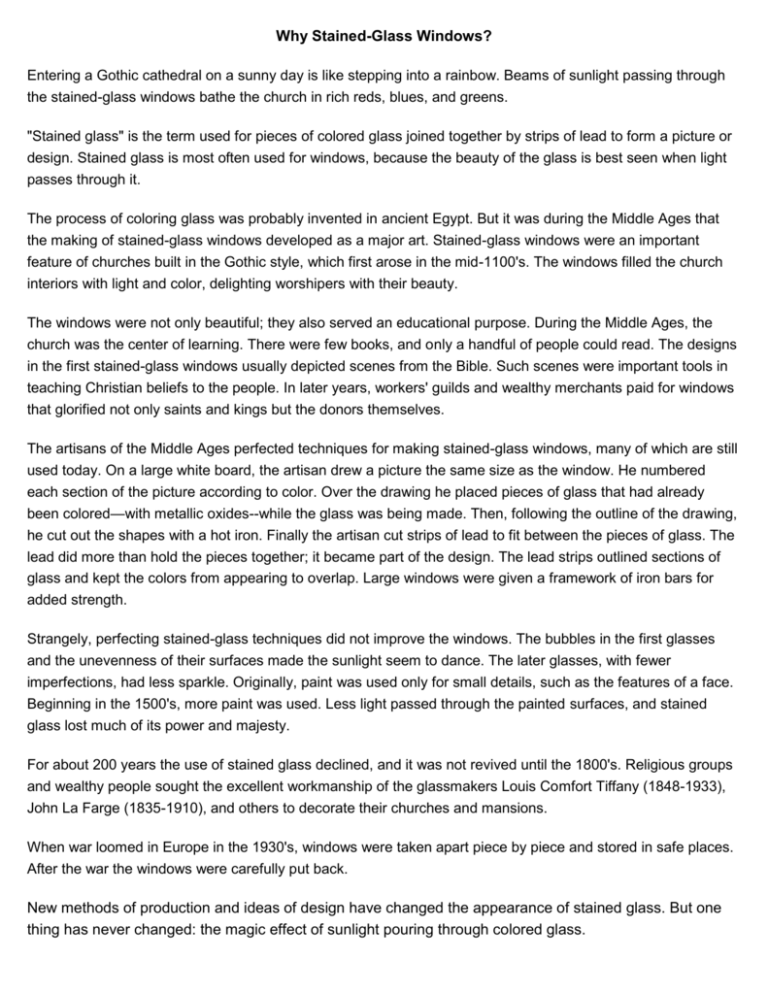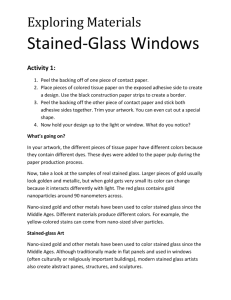Why Stained-Glass Windows
advertisement

Why Stained-Glass Windows? Entering a Gothic cathedral on a sunny day is like stepping into a rainbow. Beams of sunlight passing through the stained-glass windows bathe the church in rich reds, blues, and greens. "Stained glass" is the term used for pieces of colored glass joined together by strips of lead to form a picture or design. Stained glass is most often used for windows, because the beauty of the glass is best seen when light passes through it. The process of coloring glass was probably invented in ancient Egypt. But it was during the Middle Ages that the making of stained-glass windows developed as a major art. Stained-glass windows were an important feature of churches built in the Gothic style, which first arose in the mid-1100's. The windows filled the church interiors with light and color, delighting worshipers with their beauty. The windows were not only beautiful; they also served an educational purpose. During the Middle Ages, the church was the center of learning. There were few books, and only a handful of people could read. The designs in the first stained-glass windows usually depicted scenes from the Bible. Such scenes were important tools in teaching Christian beliefs to the people. In later years, workers' guilds and wealthy merchants paid for windows that glorified not only saints and kings but the donors themselves. The artisans of the Middle Ages perfected techniques for making stained-glass windows, many of which are still used today. On a large white board, the artisan drew a picture the same size as the window. He numbered each section of the picture according to color. Over the drawing he placed pieces of glass that had already been colored—with metallic oxides--while the glass was being made. Then, following the outline of the drawing, he cut out the shapes with a hot iron. Finally the artisan cut strips of lead to fit between the pieces of glass. The lead did more than hold the pieces together; it became part of the design. The lead strips outlined sections of glass and kept the colors from appearing to overlap. Large windows were given a framework of iron bars for added strength. Strangely, perfecting stained-glass techniques did not improve the windows. The bubbles in the first glasses and the unevenness of their surfaces made the sunlight seem to dance. The later glasses, with fewer imperfections, had less sparkle. Originally, paint was used only for small details, such as the features of a face. Beginning in the 1500's, more paint was used. Less light passed through the painted surfaces, and stained glass lost much of its power and majesty. For about 200 years the use of stained glass declined, and it was not revived until the 1800's. Religious groups and wealthy people sought the excellent workmanship of the glassmakers Louis Comfort Tiffany (1848-1933), John La Farge (1835-1910), and others to decorate their churches and mansions. When war loomed in Europe in the 1930's, windows were taken apart piece by piece and stored in safe places. After the war the windows were carefully put back. New methods of production and ideas of design have changed the appearance of stained glass. But one thing has never changed: the magic effect of sunlight pouring through colored glass. Name ______________________________________ Use the article to answer the following questions. 1. What is a stained glass window? _____________________________________________________ _______________________________________________________________________________ 2. Explain the purpose of stained glass windows in the Middle Ages. ___________________________ _______________________________________________________________________________ _______________________________________________________________________________ 3. How were stained glass windows created/constructed during the Middle Ages?_________________ _______________________________________________________________________________ _______________________________________________________________________________ 4. What was the advantage and effect to stained glass windows not being perfect?________________ _______________________________________________________________________________ _______________________________________________________________________________ 5. The use of stained glass windows declined at one point in history. What occurred that revived the use of the windows? _______________________________________________________________ _______________________________________________________________________________ _______________________________________________________________________________ 6. Explain how stained glass windows were protected and preserved prior to, and during, WWII in Europe. _________________________________________________________________________ _______________________________________________________________________________ _______________________________________________________________________________





